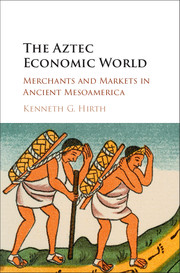Book contents
- Frontmatter
- Contents
- List of figures
- List of tables
- Preface
- Abbreviations
- 1 Introduction to the Aztec economic world
- 2 The structure of Mesoamerican economy
- 3 The Mesoamerican marketplace
- 4 Merchants, profit, and the precolumbian world
- 5 Often invisible: domestic entrepreneurs in Mesoamerican commerce
- 6 The professional retail merchants
- 7 Merchant communities and pochteca vanguard merchants
- 8 The tools of the trade and the mechanics of commerce
- 9 Conclusions
- Notes
- Glossary of Nahuatl and early colonial Spanish terms
- Bibliography
- Index
1 - Introduction to the Aztec economic world
Published online by Cambridge University Press: 05 May 2016
- Frontmatter
- Contents
- List of figures
- List of tables
- Preface
- Abbreviations
- 1 Introduction to the Aztec economic world
- 2 The structure of Mesoamerican economy
- 3 The Mesoamerican marketplace
- 4 Merchants, profit, and the precolumbian world
- 5 Often invisible: domestic entrepreneurs in Mesoamerican commerce
- 6 The professional retail merchants
- 7 Merchant communities and pochteca vanguard merchants
- 8 The tools of the trade and the mechanics of commerce
- 9 Conclusions
- Notes
- Glossary of Nahuatl and early colonial Spanish terms
- Bibliography
- Index
Summary
In the modern world, international commerce provides more links between the people of different nations than all the political, religious, and humanitarian delegations combined. Every day, millions of goods are produced, shipped, bought, and sold by over seven billion people around the world. People pay little attention to where these goods come from. Instead, they simply expect them to appear on the shelves of their local grocery stores or in the public marketplace. The ingredients for even a simple lunch can come from many different places around the world, the result of modern commercial networks and how efficiently they mobilize the products we consume. These networks, of course, are not new. The movement of resources from producers to consumers in rural and urban settings has been an indispensable part of large-scale societies throughout human history. Two important questions for the study of ancient economy, of course, are what types of goods moved through regional networks during preindustrial times, and in what volume?
The way goods are transferred from producers to consumers takes many different forms. In the modern world, goods and money move through multiple channels as wages, gifts, grants, and taxes to name a few, each representing a different sphere of distribution and exchange. The same was true for the distant past; goods and resources moved through multiple economic and social channels in large-scale ancient societies. One of the challenges of social historians is to reconstruct the economic organization of ancient societies where information is limited or of uneven quality. As societies grew in size the goods needed to provision them often had to move over further and further distances. One of the solutions to this problem in many places around the world was the appearance of merchants and merchant groups who were the agents that bridged the gap between producers and consumers.
The merchant, whether male or female, is an exchange and transportation specialist. They procure goods or resources and move them over space to their final consumers. Whether merchants link producers directly with consumers or form part of a network through which consumables flow is simply a matter of scale. Their function remains the same: they provide a provisioning function from which they obtain a portion of their livelihood.
- Type
- Chapter
- Information
- The Aztec Economic WorldMerchants and Markets in Ancient Mesoamerica, pp. 1 - 18Publisher: Cambridge University PressPrint publication year: 2016



